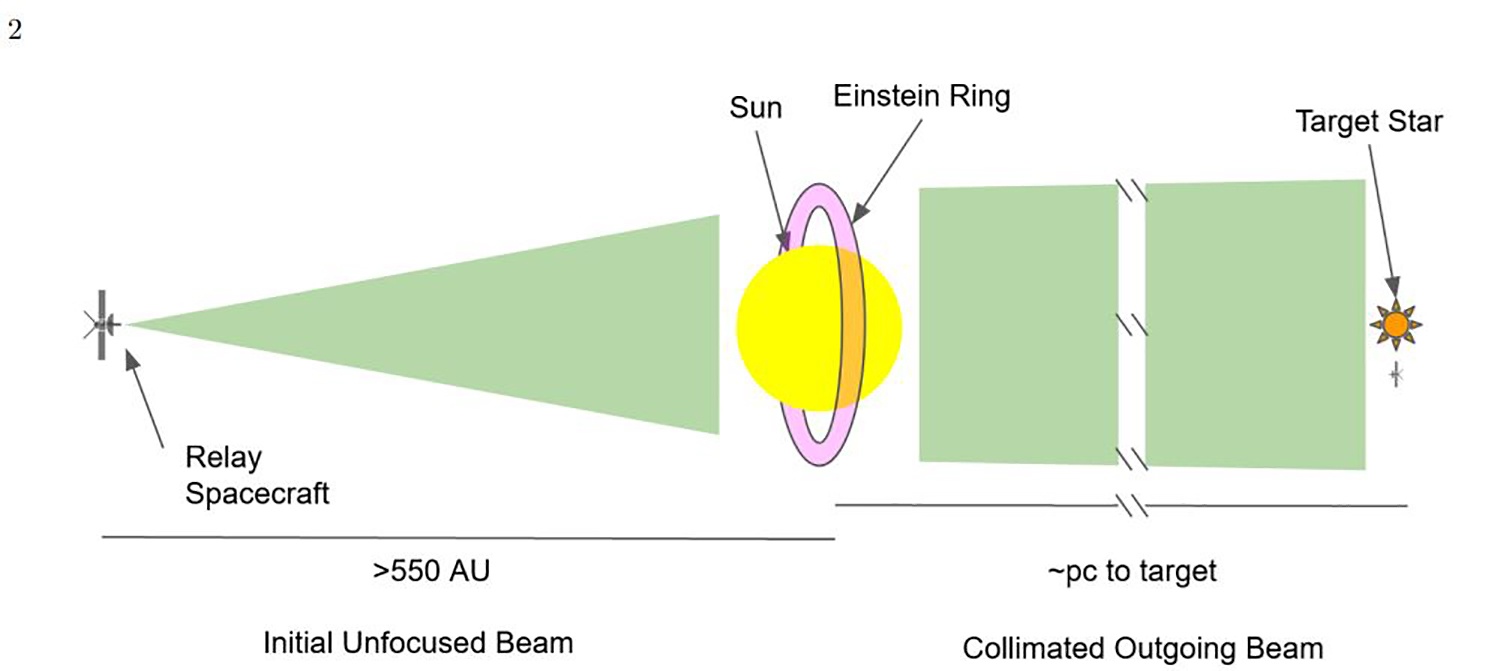
Like a lens, stars can focus a distant source of light, such as a radio signal, greatly boosting signal gain or likewise focus an outgoing signal for better transmission.
As our Sun’s gravity focuses light, a receiving or transmitting craft can be placed along an axis that runs between a distant target star where a signal may originate, the Sun, and a focal line where the Sun focuses that signal from the target star.The target star then is directly opposite the spacecraft on the other side of the Sun which the spacecraft sees not through but around the Sun as the Sun bends light around itself due to gravity.
Imagine it like an eyeball – the Sun is the lens of your eye with the spacecraft the back of your retina (but the light is going around the glass of the “lens” rather than through it).
As signals are received, the craft could relay information to the Earth or send the signal to another transmitter/receiver stationed around the Sun aligned with a different distant target star to forward the signal onward.A connection to another star system would require another craft stationed at the distant target star.
How much signal gain could be achieved by the Sun’s gravitational lens.Our Sun’s wobble is the largest disruption of alignment between a distant target star, the Sun, and a communication spacecraft.
Alternatively, the telescope could point toward to Sun to ensure the target star from which a signal is being received is fixed in the Sun’s Einstein Ring.
Just as the Einstein Ring picture of LRG 3-757 above shows how a distant background galaxy shines around a closer foreground galaxy, a distant target star from which the spacecraft is receiving a transmission would appear as a ring of light encircling the Sun from the craft’s perspective.
Exotic thrusters like antimatter may be more easily detectable than other forms of propulsion meaning if there is a communication craft already in our solar system placed there by another civilization we might be able to see it.
Well, if an alien spacecraft is using our Sun’s gravitational lens, it will be difficult to detect as it would be hundreds of AU away – a future area of interest for artifact SETI research (Search for Extraterrestrial Intelligence searching for alien artifacts).
If Earth doesn’t pass through this cone of signal, a network of alien communication cloud pass right through our solar system undetected– an explanation to the quietness of the galaxy if there are alien civilizations using gravitationaly lensed signals.
Assuming that gravitational lensing is being used for interstellar communication, and that some star systems may make better receiving/transmitting points than others, we could narrow radio SETI (Search for ETI using radio transmissions) searches to these ideal systems.We could then search for outbound/inbound signals from a region opposite of their location in our own solar system where their light would be focused by our Sun toward a potential transmitting/receiving craft.
The craft would repeat this orbit in sequence with other probes so that each spacecraft reduced the overall fuel cost required remain in place while at least one craft always remained in focus.
But just as the Sun’s lensing effect boosts signal gain, so too would the effect magnify distant star systems and other cosmic objects creating a giant super telescope.
And if we ever do launch a gravitational lens scope/transmitter, perhaps we’ll find another one already out there from someone else.
[2109.08657] Stellar Gravitational Lens Engineering for Interstellar Communication and Artifact SETI (arxiv.org) (Originating Open Access Research Article by Kerby and Wright)If We Used the Sun as a Gravitational Lens Telescope, This is What a Planet at Proxima Centauri Would Look Like – Universe TodayWhat is Gravitational LensingThe Ultimate Space Telescope Would Use the Sun as a Gravitational Lens | Daily Planet | Air & Space Magazine (airspacemag.com)solar gravitational lens TVIW-presentation (nasa.gov)